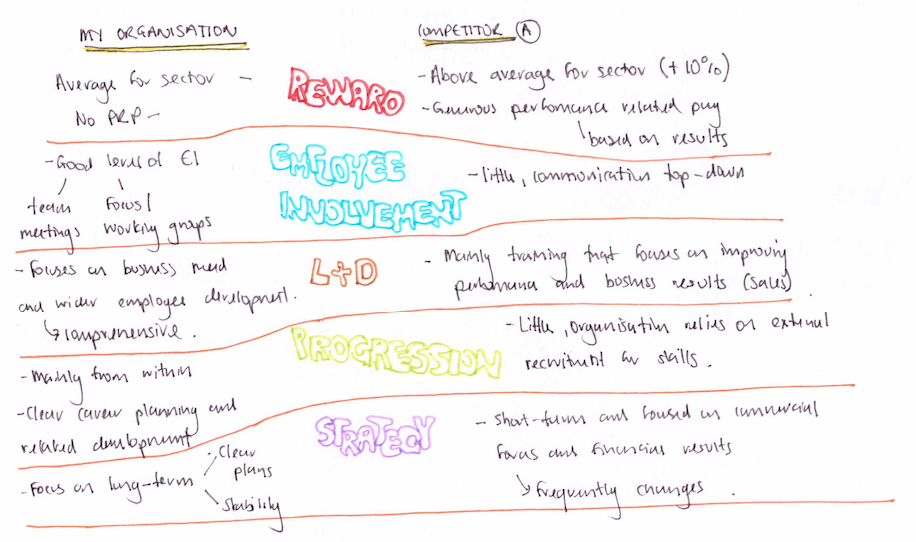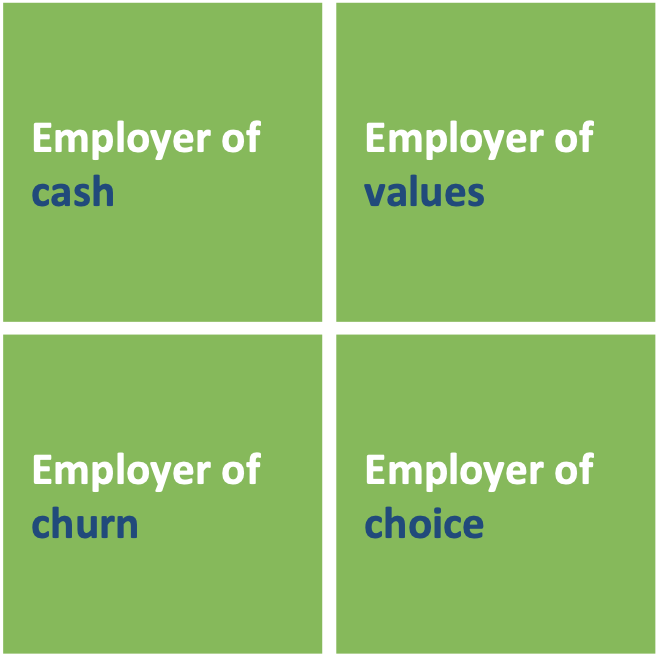learning resources
How organisations position themselves in competitive labour markets
Overview
According to Taylor and Woodhams (2012) to be successful, an organisation needs to develop a resourcing strategy which attracts the right people and differentiates the organisation from the competition.
These learning resources explore how organisations position themselves in competitive labour markets. This very much follows on from the YouTube clip about tight and loose labour markets and their impact on resourcing in organisation. In the audio clip (to the right) your HR tutor Andrew gives an overview of the purpose and content of this learning, and below is a summary of how this fits with the CIPD units.
Version 1.1 – updated February 2024.
Associate (level 5)
This learning relates to unit 5HR02 – Talent management and workforce planning
AC 1.1 – Explain how organisations strategically position themselves in competitive labour markets.
Advanced (level 7)
This learning relates to unit 7HR02 – Resourcing and talent management to sustain success
AC 1.4 – Compare ways in which organisations build and maintain a positive reputation in key labour markets by offering compelling employee value propositions.
1. Competitor analysis
A competitor analysis seeks to evaluate the competitive landscape and to identify all the direct and indirect competitors in the battle for talent within the labour market (Taylor and Woodhams, 2012). A competitor analysis looks at different strategic aspects of the organisation’s competitors, including:
- What is the brand image of each competitor?
- How is each competitor positioned within the market?
- What strengths and weaknesses does each competitor have?
- How does the target group of talent perceive each competitor as an employer?
Other factors considered include:
- Salary offered
- Other benefits, for example, flexible working
- Employment security
- Job roles
- Working environment
- Opportunities for training and development
- The ‘kudos’ from working for a specific organisation.
The analysis should not only assess the current situation, but the future situation too. For instance, is there any evidence to suggest that the competitor is developing an employer brand?
A competitor analysis is used to identify all aspects of the competitor which might influence the organisations resourcing strategy. The results gained through detailed research enables an organisation to identify its own corporate aspects which differentiate it as an employer and allow the positioning of the employer brand in the labour market.
Taylor, S. and Woodhams, C. (2012) Managing People and Organisations, London, CIPD.
Activity
Carry out Internet research to determine the relative strengths and weaknesses of your organisation’s labour market competitors, and make some brief notes.
Click on the image on the right for an example of what that might look like, including the areas you could compare the organisations on, such as reward and learning and development.

Competitive advantage
Jeffrey Pfeffer (1994) reminds us why the development of an effective resourcing strategy is important for business success. His research suggests that by introducing a mix of best practice initiatives, organisations can create high performing teams that differentiate the organisation from their competitors.
Best practice doesn’t mean best fit for all organisations. Each organisation needs to build their own unique blend of initiatives aligned to organisational aims and objectives, and appropriate to the strategic approach taken by the organisation. The best practice initiatives are:
- Employment security
- Selectivity in recruiting
- High wages
- Incentive pay
- Employee ownership
- Information sharing
- Participation and empowerment
- Self-managed teams and job redesign
- Training and skill development
- Cross-utilization and cross-training
- Harmonisation
- Promotion from within
- Long-term perspective
- Measurement of the practices
- Overarching philosophy.
More recent research commissioned to the University of Bath by the CIPD looks at HR and its Role in Innovation; this was published in April 2013 and offers a model for organisations to consider when building a sustainable organisation for the future.
Pfeffer, J (1994) Competitive Advantage Through People, Boston, Harvard University Press.
2. Organisational positioning
An organisation can choose how it wishes to position itself within the labour market. Higgs (2004) offers a useful model based on two factors:
- Reward: the amount of money paid to employees
- Culture: the extent to which employees are respected and treated ethically.
The model identifies four organisational positions:
- Employer of cash: tends to treat employees quite harshly, perhaps expecting them to work very long hours, but compensates them very well.
- Employer of values: cannot afford to pay the going market rate but demonstrates its commitment to treating employees well, for example, through fair treatment, rewarding work, job security, and so on.
- Employer of churn: pays poorly and treats employees badly and usually has high staff turnover. Tends to target low skill levels or those with little choice of alternative employment.
- Employer of choice: practices, policies, benefits and overall work conditions have enabled it to successfully attract and retain talent because employees choose to work there.
Higgs, M. ‘Future Trends in HRM’ cited in Taylor, S. and Woodhams, C. (2012) Managing People and Organisations, London, CIPD.
Activity
Try to categorise your organisation’s labour market competitors according to the four groups on Higg’s model (it will help to revisit your findings from the activity above). Are they employers of cash, values, churn or choice? Do you notice any characteristics that define these groupings?

Employee value proposition (EVP)
An employee value proposition is made up of what an organisation has to offer that prospective or existing employees would value and which would help to encourage them to join or stay with the business (Armstrong, 2012). It will include both financial and non-financial factors. Non- financial factors, such as the extent to which the organisation behaves responsibly, respect – diversity and inclusion, work–life balance and opportunities for personal and professional growth, may be critical in attracting and retaining talent. The aim is to become ‘an employer of choice’ – an organisation people want to work for and stay with.
Armstrong, M. (2012) Armstrong’s Handbook of Human Resource Management Practice,12thedn., London, Kogan Page,
3. Employers of choice and employer branding
The term ‘employer of choice’ has traditionally been associated with recruitment and strategies to attract and retain desired staff.
Research indicates that desirable qualities for organisations to be considered employers of choice include (Gill, 2011):
- strong leadership and inter-relationships
- high standards for safety and wellbeing
- opportunity for staff development
- inclusion policy and traditions
- ethical community involvement and sustainable practice.
It is clear that organisations that invest in their people are perceived to be better places to work and are more likely to retain key staff and outperform other organisations on financial measures.
On being an employer of choice Purcell et al. (2003) comment that:
‘What seems to be happening is that successful firms are able to meet people’s needs both for a good job and to work ‘in a great place’. They create good work and a conducive working environment. In this way they become an ‘employer of choice’. People will want to work there because their individual needs are met – for a good job with prospects linked to training, appraisal and working with a good boss who listens and gives some autonomy but helps with coaching and guidance.’
Gill, R. (2011) ‘An Integrated Literature Review: Strengthening Reputation through EOC and CSR’, International Journal of Humanities and Social Science, Vol. 1 No. 12.
Purcell, J, Kinnie, K, Hutchinson, S, Rayton, B and Swart, J (2003) People and Performance: How people management impacts on organisational performance, London, CIPD.
Activity
According to Taylor and Woodhams (2016), companies perceived to be employers of choice tend to make it on to the Sunday Times list of the ‘100 best companies to work for’.
Follow the link to the best companies list and review a couple of the profiles. Make a note of what makes this company a great place to work. You may want to focus on organisations in the same sector and of a similar size to your organisation to see how they differ.
Employer branding
From its research, the CIPD has defined employer branding as:
“…a set of attributes and qualities, often intangible, that makes an organisation distinctive, promises a particular kind of employment experience, and appeals to those people who will thrive and perform best in its culture”.
Employer branding is the creation of a brand image of the organisation for prospective employees. It will be influenced by the reputation of the organisation as a business or provider of services as well as its reputation as an employer. Of course, not all employer brands will be attractive to all people.
The difference between employer branding and ‘employer of choice’ seems to be the ‘employer of choice’ has good employment practice and benefits whereas employer branding is more about the message that wraps around those good practice and benefits.
In the wake of the global financial crisis, many organisations are recognising the business benefits and opportunities that can develop from embedding a responsible and sustainable ethos into the organisation and employer brand. According to Taylor and Jenner (2007) there are four main reasons why the concept of employer branding has become prominent in recent years:
- brand power
- credibility
- employee engagement
- prevailing labour market conditions.
CIPD (2023) Factsheet: Employer brand, CIPD [Online]. Available at: https://www.cipd.org/uk/knowledge/factsheets/recruitment-brand-factsheet/ (Accessed: 19 February 2024).
Taylor, S. and Jenner, S. (2007) Research Insight Employer branding: the latest fad or the future of HR?, London, CIPD.
Activity
On the right is a short YouTube video ‘Build your employer brand: A strategic approach to recruitment and retention’ in which Leandra Harris, Randstad Canada’s Executive VP of Human Resources, explores the topic of employer branding, from identification and definition of brand values, to leveraging it as a marketing tool to strategically attract talent.
Contact Andrew
andrewwales_lod@btinternet.com
